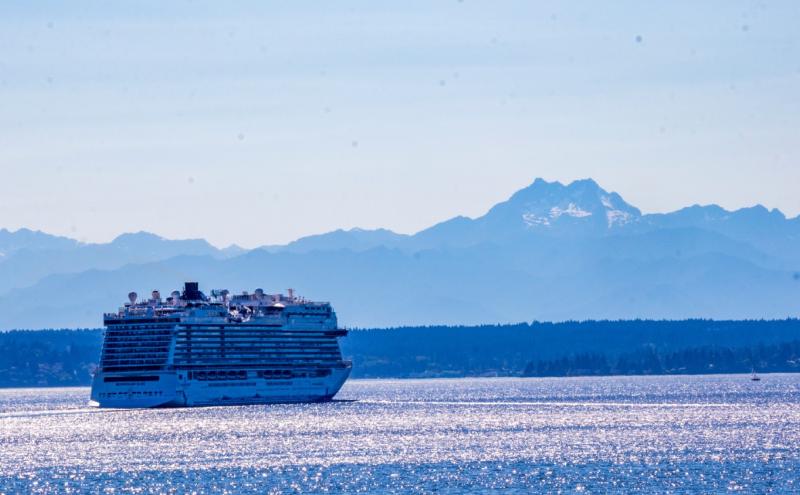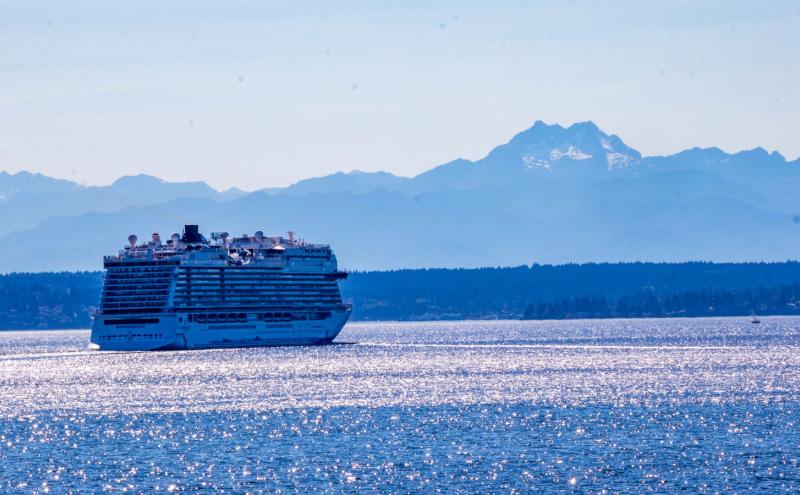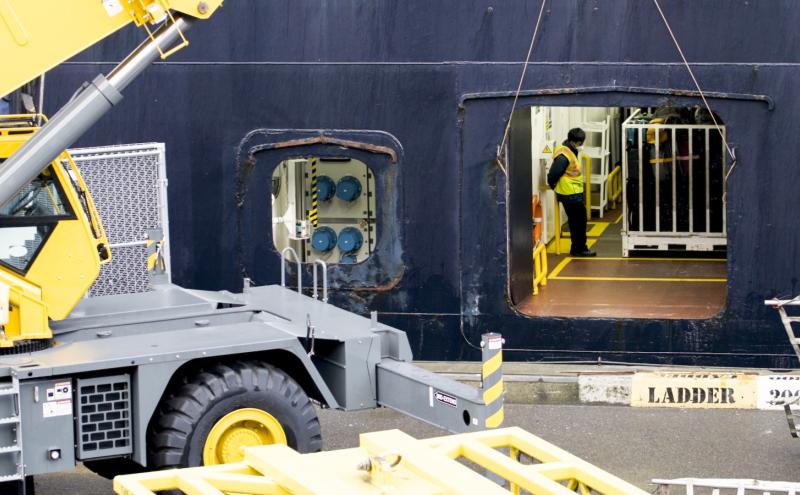
The Pacific Northwest to Alaska Green Corridor project is a collaborative partnership between the major cruise lines, homeports, and several ports of call in the Alaska cruise market to work together to explore low and zero- greenhouse gas (GHG) emission cruising from between Washington, British Columbia, and Alaska. ‘First Mover’ partners include Port of Seattle, Vancouver Fraser Port Authority, Greater Victoria Harbour Authority, the Alaskan port communities of Haines, Juneau, Sitka, and Skagway, Carnival Corporation, Norwegian Cruise Line Holdings, Royal Caribbean Group, Cruise Lines International Association, the Global Maritime Forum, Blue Sky Maritime Coalition, and Washington Maritime Blue.
What is a Green Corridor?
Green corridors are maritime routes focused on accelerating the adoption of zero-emission fuels and technologies in shipping. Shipping accounts for nearly 3 percent of GHG emissions globally. While some sectors have clear pathways for how to transition away from fossil fuels, like the electrification of passenger cars, there is not yet a silver bullet solution to decarbonize large 'oceangoing vessels' - ships traveling long distances at sea such as marine cargo and cruise ships. While several options for zero-emission maritime fuels are emerging and being tested in ships around the world, challenges remain to overcome technical, regulatory, and financial hurdles to using zero-emission maritime fuels and technology at scale.
Green corridors bring together the key players within the industry - ports, ship owners, cargo owners, policymakers, fuel producers, and others - to tackle these challenges together. Partnering across the supply chain allows each entity to coordinate their timelines and investments to ensure the production of new maritime fuels can be met with demand from ships equipped to use those fuels and infrastructure to deliver those fuels to maritime customers. By solving these challenges and demonstrating zero-emission shipping along a specific route, a green corridor can spur the development and deployment of cleaner ships and fuels across the industry.
Green corridors as a concept emerged in 2021 when twenty-four countries, including the United States and Canada, signed the Clydebank Declaration to support the establishment of at least six green shipping corridors by 2025 while aiming to scale up activity in future years. Many different green corridor projects have been announced around the world since then, all with a common focus to address the technical, regulatory, and financial feasibility barriers to use cleaner maritime fuels.
- Mission Innovation Zero Emission Shipping developed an interactive map tracking all announced green corridor routes around the world, including the Pacific Northwest to Alaska Project.
The Pacific Northwest to Alaska Green Corridor defines a green corridor as "A shipping route where low and zero GHG emission solutions are demonstrated and supported through collaboration across sectors to accelerate maritime decarbonization."
Why create a Green Corridor to Alaska?
Four powerful reasons make the Pacific Northwest to Alaska corridor the right home for the world's first green corridor project to include cruise ships.
Climate Urgency
-
Plans are already underway for Pacific Northwest ports and industry to chart a course to zero-emissions. Ambitious climate action is needed now to ensure our collective success in the future.
-
Actions that mitigate climate change will help preserve the sensitive habitats that people cruise to see.
Environmental Justice
-
A green corridor and the transition away from fossil fuels can accelerate environmental justice for near-port communities that experience more exposure to air pollution and the effects of a changing climate.
Economic Opportunity
-
A green corridor creates potential for maritime jobs and industries to be at the center for the decarbonization transition.
We are Ready
-
The Pacific Northwest to Alaska Green Corridor project builds on a history of environmental leadership and innovation in the region with successful partnerships among ports and the cruise industry toward environmental action.
-
The Pacific Northwest is a highly diversified hub for maritime research and development, innovation, engineering, and for private sector companies pioneering clean technologies and maritime fuels.
-
National, state, and provincial laws, programs, and funding opportunities are already in place that support reducing carbon emissions from transportation.
-
A distinct maritime corridor exists between Puget Sound and Alaska with regularly scheduled vessel calls by cruise, commercial fishing, cargo, ferries, and tug industries.
Read more in the Green Corridor one-pager
About the Pacific Northwest to Alaska Green Corridor Project
The Pacific Northwest to Alaska Green Corridor (PNW2AK) project is exploring a maritime green corridor to accelerate the deployment of zero GHG emission ships and operations between Alaska, British Columbia, and Washington.
In March 2023, First Mover project partners finalized a Project Charter outlining the project's objectives, definitions, values, governance, and general approach for a feasibility study. In the Project Charter, partners commit to:
-
Working together to explore the feasibility of a green corridor in the Pacific Northwest of North America, including, but not limited to, further defining the scope and application of the green corridor concept;
-
Enhancing and supporting the emission-reduction efforts already underway and using the green corridor as a testbed for low and zero greenhouse gas technologies and ships, as feasible; and
-
Working collaboratively to define the governance structures, terms, and frameworks needed to guide this regional effort.
Pacific Northwest to Alaska Green Corridor Webinar Recording, 4/6/2023
Feasibility Study
In the Project Charter, First Movers outlined a multi-phase approach to a feasibility study to explore the use of low- and zero-GHG fuels in cruise. Partners developed a draft Scoping Proposal in early 2023 that outlines topics of interest for the study to cover.
First Movers engaged the Mærsk Mc-Kinney Møller Center for Zero Carbon Shipping (The Center) to leverage The Center's blueprint methodology for assessing the feasibility of green corridors. First Movers are in the final phases of discussion to confirm the project objectives and begin technical work. The study is expected to explore the feasibility of cruise ships running on green methanol in the Pacific Northwest by the early 2030s. It will evaluate the demand, production, and availability of green methanol for use as a maritime fuel in the region, the delivery of cruise ships able to run on green methanol, and the readiness for bunkering of green methanol at our Port. Results are expected in 2025.
The Center is involved in several green corridor efforts around the world, including a cargo shipping green corridor involving the Northwest Seaport Alliance and the Republic of Korea.
Progress
- 2022: Launched partnership at the International Association of Ports and Harbors World Ports Conference in Vancouver, BC
- 2023:
- Signed a Project Charter
- Convened a public webinar with +150 attendees
- Scoped feasibility study and engaged support of Mærsk Mc-Kinney Møller Center for Zero Carbon Shipping
- 2024 Priorities:
- Launch a Green Methanol Feasibility Study
- Explore approaches to measure and track GHG emissions
- Coordinate across partners on policy engagement, funding, and early action opportunities
Project Partners
-
Port of Seattle, Washington
-
Vancouver Fraser Port Authority, British Columbia
-
Haines Borough, Alaska
-
City and Borough of Juneau, Alaska
-
City and Borough of Sitka, Alaska
-
Municipality of Skagway, Alaska
-
Carnival Corporation and its cruise brands including Princess, Holland America Line, Carnival, Seabourn, and Cunard
-
Norwegian Cruise Line Holdings and its cruise brands including Norwegian Cruise Lines, Oceania Cruises, and Regent Seven Seas Cruises
-
Royal Caribbean Group and its cruise brands including Royal Caribbean International, Celebrity Cruises, and Silversea Cruises
While currently focused on cruise travel between Washington, British Columbia, and Alaska, the project may expand to other maritime sectors or other regional ports in the future. The initial focus, however, is on the cruise corridor as there are unique aspects of cruise travel to account for when assessing the feasibility of a zero-emission ship and corridor. We welcome interest from all sectors of the maritime industry and other regional ports.



